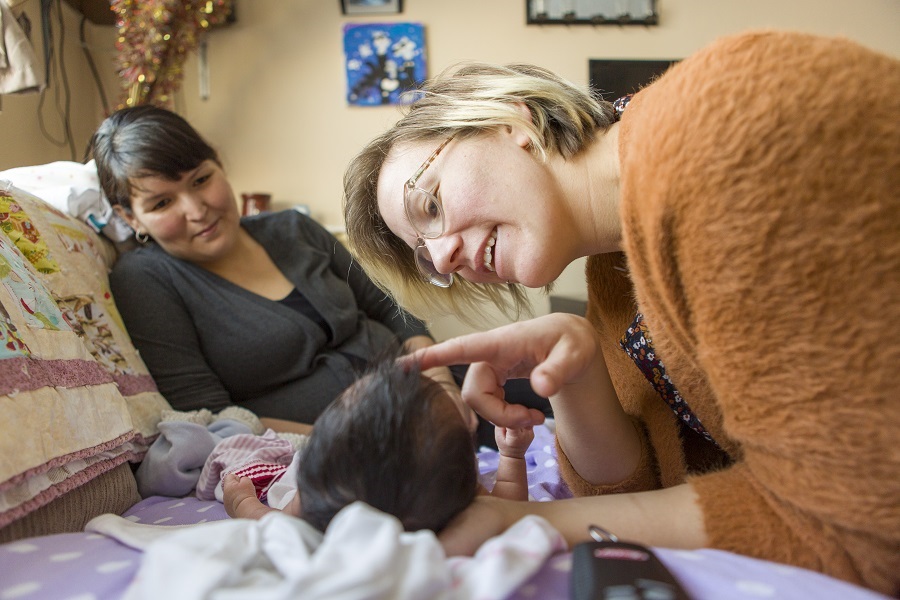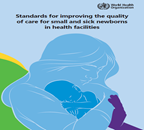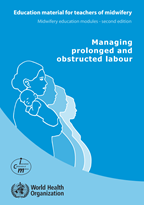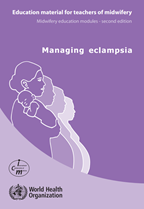Midwifery education and care
Overview
Midwifery is defined as “skilled, knowledgeable and compassionate care for childbearing women, newborn infants and families across the continuum from prepregnancy, pregnancy, birth, postpartum and the early weeks of life”. The evidence shows us that midwifery plays a “vital” role, and when provided by educated, trained, regulated, licensed midwives, is associated with improved quality of care and rapid and sustained reductions in maternal and newborn mortality.
All women and newborns have a right to a quality of care that enables a positive childbirth experience that includes respect and dignity, a companion of choice, clear communication by maternity staff, pain relief strategies, mobility in labour and birth position of choice. Midwives are essential to the provision of quality of care, in all settings, globally.

Midwife examines a newborn
Midwifery education and quality of care
The evidence is clear. Strengthening midwifery education to international standards is a key step to improving quality of care and reducing maternal and newborn mortality and morbidity. The Framework for Action to Strengthen Midwifery Education is a guide to develop high-quality, sustainable pre- and in-service education to save lives. It has been developed by WHO, UNFPA, UNICEF and ICM and includes a seven-step action plan for use by all stakeholders in maternal and newborn health.
Midwifery education is a key solution to the challenge of providing universal and quality maternal and newborn care to meet our Sustainable Development Goals. While improving access to care is critical, ensuring good quality of care has an even greater impact in terms of lives saved. WHO, ICM, UNFPA and UNICEF are finalising a report and action plan for strengthening quality midwifery education to be released at the World Health Assembly, 20-28 May 2019.
Developing leadership in global midwifery
WHO is working hard to provide a solution is to transform midwifery education through the first global, in-service, evidence based interprofessional Midwifery Education Tool kit. This tool kit brings together maternal, newborn, sexual, reproductive and mental health for life-long learning in compassionate midwifery care, including during pandemics and for use in fragile and humanitarian settings. Focused on a midwifery model of continuity of care, putting women, newborns and their families at the center, this toolkit provides midwives with all the training required to care for healthy women and their newborns, prevent unnecessary interventions, while ensuring lifesaving actions and enable health professionals to work effectively in a multi-disciplinary team.
Midwifery education is designed to address three strategic priorities:
- All midwives should be educated to high standards and enabled to practise to their full scope
- Midwives should be involved in education policy at the highest level
- Education processes should be coordinated and aligned
The case for midwifery
Who is a midwife?
A midwife is a person who, having been regularly admitted to a midwifery educational programme, duly recognized in the country in which it is located, has successfully completed the prescribed course of studies in midwifery and has acquired the requisite qualifications to be registered and/or legally licensed to practice midwifery. (ICM 2005)
Who is a skilled birth attendant?
Skilled health personnel, as referenced by SDG indicator 3.1.2, are competent maternal and newborn health (MNH) professionals educated, trained and regulated to national and international standards. They are competent to: (i) provide and promote evidence-based, human-rights based, quality, socioculturally sensitive and dignified care to women and newborns; (ii) facilitate physiological processes during labour and delivery to ensure a clean and positive childbirth experience; and (iii) identify and manage or refer women and/or newborns with complications. In addition, as part of an integrated team of MNH professionals (including midwives, nurses, obstetricians, paediatricians and anaesthetists), they perform all signal functions of emergency maternal and newborn care to optimize the health and well-being of women and newborns. Within an enabling environment, midwives trained to International Confederation of Midwives (ICM) standards can provide nearly all of the essential care needed for women and newborns. (In different countries, these competencies are held by professionals with varying occupational titles.) Reference: WHO, UNFPA, UNICEF, ICM, ICN, FIGO and IPA 2018
Key messages
When midwives are educated to international standards, and midwifery includes the provision of family planning, it could avert more than 80% of all maternal deaths, stillbirths and neonatal deaths. Achieving this impact also requires that midwives are licensed, regulated, fully integrated into health systems and working in interprofessional teams.
Beyond preventing maternal and newborn deaths, quality midwifery care improves over 50 other health-related outcomes, including in sexual and reproductive health, immunization, breastfeeding, tobacco cessation in pregnancy, malaria, TB, HIV and obesity in pregnancy, early childhood development and postpartum depression.
Midwives are uniquely able to provide essential services to women and newborns in even the most difficult humanitarian, fragile and conflict-affected settings. This means that midwives will make a significant contribution to delivering on the commitments made in the Astana Declaration on Primary Health Care and the Global Action Plan on Healthy Lives and Well-Being.
Educating midwives to international standards is a cost-effective investment as it saves resources by reducing costly and unnecessary interventions
Yet there is a startling lack of investment in quality midwifery education, despite the evidence of impact. Now is the time to take collective action.
Policy
Midwives can provide about 90% of the SRMNAH care needed, but they account for less than 10% of the global SRMNAH workforce. The world needs 900,000 more midwives. By 2030, the midwife shortage will be smaller (750,000), but there will still be a major gap between the number required and the workforce available in midwifery.
The gap between low-income countries and high- and middle-income countries is projected to widen by 2030, increasing inequality. To close the gap by 2030, 1.3 million new DSE worker posts (mostly midwives and mostly in Africa) need to be created in the next 10 years.
WHO is working on each of the 4 priority areas to strengthen the quality and quantity of midwives globally. The most recent resolution, WHA 64.7, gives WHO the mandate to develop and strengthen strategies such as: capacity of nursing and midwifery workforce through the provision of support to Member States on developing targets, action plans and forging strong interdisciplinary health teams as well as strengthening the dataset on nursing and midwifery.
Related links
Publications and resources
Interprofessional midwifery education toolkit

The Essential Childbirth Care Course (ECBC) is focused on the midwifery model of care, which puts women, newborns and their families at the center, ensures...
Key publications

Standards for improving the quality of care for small and sick newborns in health facilities
The standards for the care of small and sick newborns in health facilities define, standardize and mainstream inpatient care of small and sick newborns,...

Strengthening quality midwifery education for Universal Health Coverage 2030: Framework for action
The Framework for Action to Strengthen Midwifery Education is a guide to develop high-quality, sustainable pre- and in-service midwifery education...

Much progress has been made during the past two decades in coverage of births in health facilities; however, reductions in maternal and neonatal mortality...
Midwifery toolkit and education modules


The module begins with the story of Mrs X which shows how certain social, economic and cultural factors, combined with delays in seeking and obtaining...

The midwife in the community Midwifery education module 2
In order that students may fully understand how postpartum haemorrhage occurs, this module begins with a detailed explanation of the physiology and management...

This module begins with a review of the anatomy and physiology relevant to the management of prolonged and obstructed labour. On the basis of this, the...

Managing puerperal sepsis Midwifery education module 4
This module begins with an explanation of the problem of puerperal sepsis. The content then covers the factors which contribute to the infection, how it...

Managing eclampsia Midwifery education module 5
This module begins with an explanation of the conditions pre-eclampsia and eclampsia. The content then covers the factors which contribute to eclampsia,...

Managing incomplete abortion Midwifery education module 6
This module begins with an explanation of abortion, including the types of abortion, the effect of abortion on maternal mortality and morbidity, the prevention...
Related activities
Related links
Related health topics


